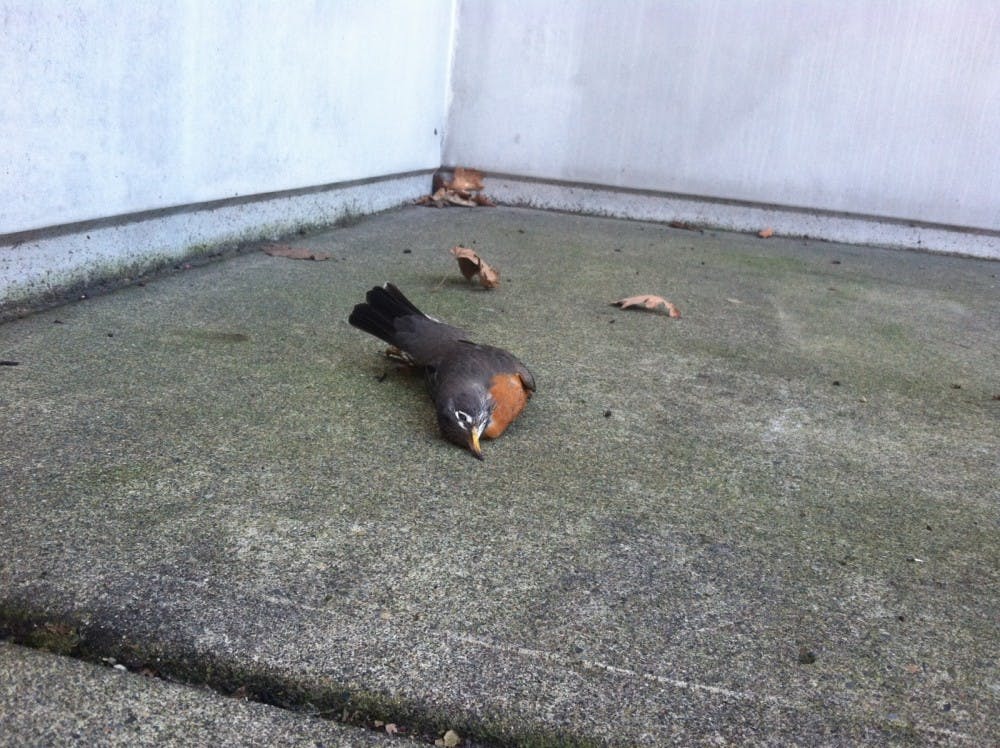Olivia Alsept-Ellis |
Many dead birds have been found along the north side of the Clark Library. However, the bird bodies have disappeared, leaving only trails of feathers. Upwards of eight dead birds alongside the library have been reported in one single sighting. Other dead birds have been sighted at Shiley Hall and Franz Hall. This issue has been brought to the attention of the Clark Library, Public Safety, Physical Plant and ASUP, although no plan of action has been proposed at this time. The Physical Plant staff have been in charge of removing the bodies when they are notified.
Freshman Phoebe O’Loane was studying at the north corner of the first floor of the library when she witnessed a bird collision last week.
“We all heard this ‘thump’ and just saw feathers,” Oloane said.
Seniors Jackson Boyle and Christian Scarcella did not witness a collision but rather discovered the morbid aftermath.
“I parked right next to the library. One of the (dead) birds was right next to the pathway and I thought, ‘Oh that’s so sad!’” Scarcella said. “And we took three steps, and there was another one in the bark. We thought, ‘That’s weird, there’s another (dead bird).’
Boyle, who was with Scarcella at the time, said they were baffled when the death toll continued to rise.
“And then there was another one and another one. There were eight bird bodies in total,” Boyle said. “The sheer number of birds!”
They said the birds were in a line formation as their bodies lay on the ground.
“They were all about four feet away from the window. It looked like they had flown into the window and bounced backwards,” Scarcella said. “They must have been going pretty fast.”
Scarcella said that it appeared that the birds could have been trying to fly through the windows or, perhaps, attacking their own reflection. Their similar positioning suggested to Scarcella that they all the met a similar fate.
The Environmental News Network reported that between 365-999 million birds per year die due to collisions with buildings or residential houses. The city of Portland published a guide for bird-friendly buildings, citing light pollution and reflective glass as a preventable causes of death for birds. Organizations, like the Fatal Light Awareness Program or FLAP, aim to increase awareness of these bird-safe measures.
Dean of the Library Drew Harrington said that bird safety measures were considered when designing the library, but the etching that would have been required was too expensive.
“I don’t know if our rate of bird deaths is higher than normal,” Harrington said. “But I do know that we experienced this at the old Library as well.”
When bird bodies are discovered, Assistant Director of the Physical Plant is notified and staff are dispatched to remove the body, as with other dead animals on campus.
“When we get it call, we pick it up,” Beeler said. “I didn’t realize that there was 8 at one time. We had a report of one today, which is normal.”
Beeler and Harrington both said that the death toll for birds this year appeared to be average.
“I’m sorry, it’s sad. Nobody wants to see the little birds dying,” Harrington said. “But (the Library) is open 7 a.m. to 2 a.m. so maybe that just lets people notice this more.”








